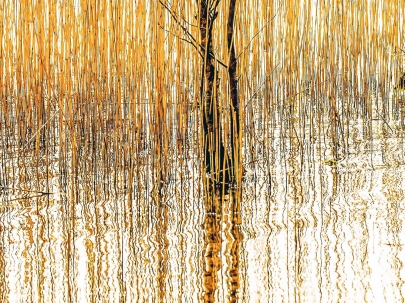Take a number of shots using lines to flatten the pictorial space. The sensor should be parallel to the subject and you may like to try a high viewpoint. (i.e. looking down). Modern Architecture offers strong lines and dynamic diagonals and zooming in can help to create simpler more abstract compositions.
But first lets pause and consider………..The difference between cropping and framing.
When cropping you take a photo then crop out the bit that interests you. In wildlife photos I have used this to get rid of clutter around the subject. This is done after the shot is taken in a dark room or on a computer.
In the first shot the whole seen is available to review. On reviewing the scene you see a shape or bird that interests you so you crop the rest of the picture away to leave what interests you. In this first photograph we start with a shot of Gannets fishing at Robin Hoods Bay. Its nice to look at but has a lot going on with tight cropping we can remove so of the business and focus on a group that show several different stages of the fish.
Framing is when you see a shot and form the composition in the viewfinder. So the picture is set up in camera and compositionally needs little or no processing. Understanding general rules of composition help make this a longer process with the camera but shorter in processing. This was taken with a wide angle lens which allowed the whole valley to be composed to show the colour of the late summer heather. Very little processing was needed back home but it took a while to set up the shot in the field. Both are dynamic cropping takes more time back in the studio whilst framing takes more effort in the field.

The Hole of Horcum in the North Yorkshire Moors.
John Swarkowski put it in a nutshell when he said. “What to include and what to leave out! Concentrate on pictures edge and the shapes they create” (1).
Before we move on I want to briefly discuss how I am feeling at the moment within the course. I have been struggling with two things.
1. reading lots of books and internet pages instead of being out with my camera.
2. When I get out with my camera I feel I am copying others work and the more I read the more I feel like this.
Imagine my joy when reading the course book led me to the Tate Gallery Homepage and then to Victor Burgin where I read the following “There are already enough images in the world… What we need to do is re-read the images we already have!!”. (2). I now feel less afraid of doing my thing with the knowledge that someone somewhere will have done it before.
Here is the exercise and my work I hope you enjoy it and it leads you to look at your own work differently.
Flat Perspective in Nature.
Reeds reflected in Lake Coniston. Taken early in the morning in warm soft light. It produces a flat abstract image of a real subject. The lines are very clean and reflected together they take you down and out of the shot. It doesn`t matter whether you look at a reed or water or the tree they all do the same thing. The only way to stay in the shot is to force your eye to stay still this is unnatural. Dan Baumbach (3) influenced me with his abstracts in Nature project.
Canon 100mm Macro f5.6 ISO200 500th of a second Shutter speed.
Pattern in brickwork. This image caught my eye as it is unusual to see the frog on bricks when in the wall as they should hold mortar. The lines take your eye to the edge of the frame then leave them there. Much as Stieglitz “Equivalents” does using clouds instead of lines your eyes end up at the edge of the frame where they have nowhere else to go. It is an uneasy experience. The shot of bricks looks and feels cropped and is far more dynamic than the shot of the whole wall.
Canon 40mm prime . ISO100 1000th of a second.
In the reading I have done I found some work completed by Walker Evans one imparticular took my eye this is
“Penny Picture Display Savannah 1936”. This picture shows many facets of society in windows. All are individuals who as a group form a picture of society.
So on a recent visit to London I went to the top of the Shard at dusk. Whilst looking at the lights of London coming on I saw into the building opposite. It had lots of windows in symmetry and looked flat. It made me think of the picture by Walker Evans and also the work I had looked at earlier with Becher and Becher.
The more I looked at this shot the more it related to Walker Evans earlier photograph. The building reminds me of a person with a hard exterior shell to protect the interior delicate workings. It also shows individuals making a society.
This work also links the two parts of this exercise very well it has the flat perspective when you look at the windows.
If you look past and through the windows you see depth and perspective within the rooms where people make the building come alive. Lines giving depth should lead somewhere or they don’t work. Perpendicular lines take you out of the picture so you have to decide how to get back into the shot.
Canon 200mm with 1.4x extender ISO 400 1/4 of a second shutter speed.
Influences in this exercise. National Geographic “Book of Photography”. Tate Gallery webpage. Liz Wells “Photography A Critical Introduction”. Stieglitz “Equivalents” photos of clouds. John Swarkowski “The Photographers Eye”. Dan Baumbach “Abstract Flora” Webpage.























